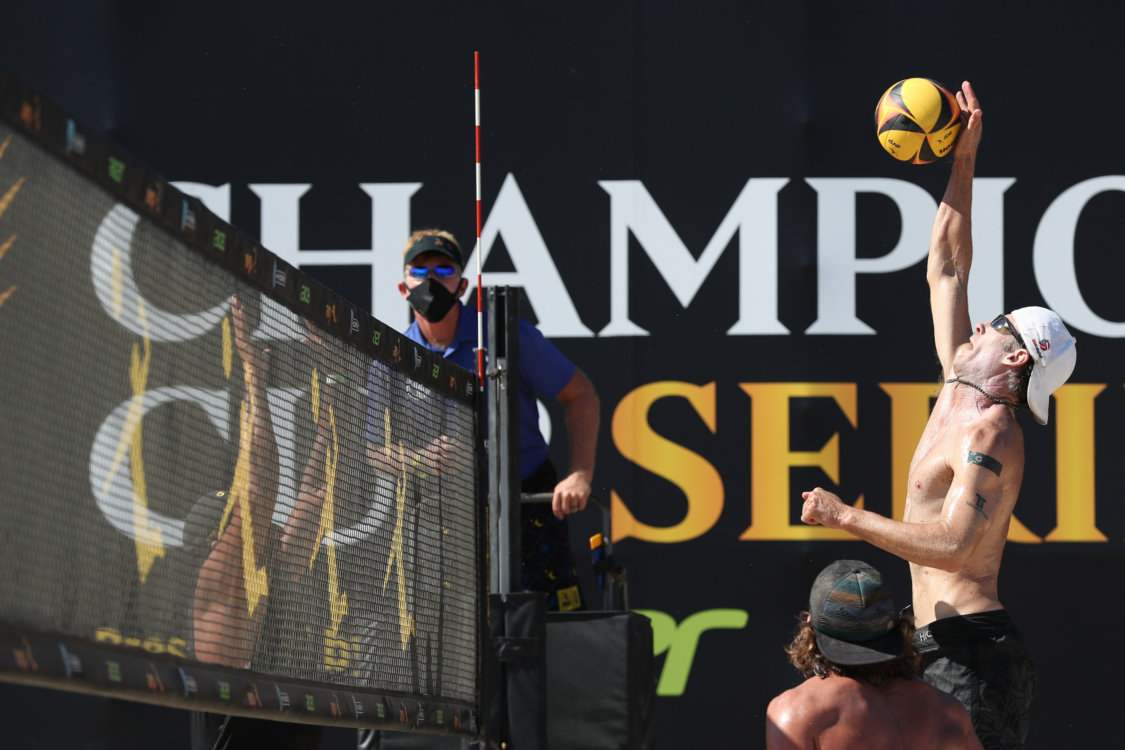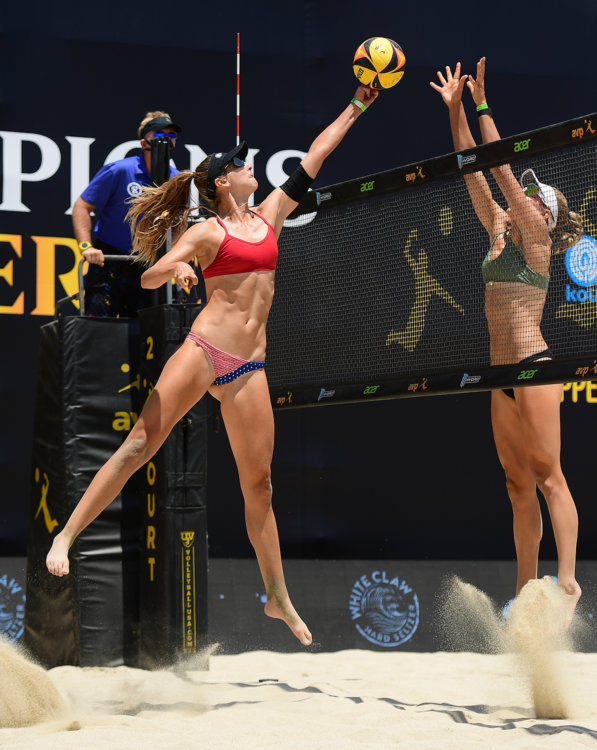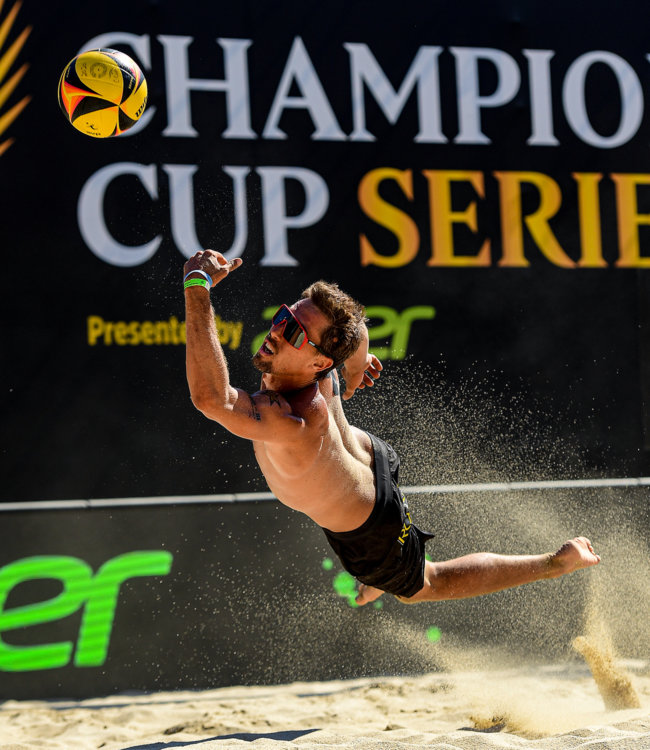Shots, shots, shots, EVERYBODY!
Sorry, I had to. Because next up in our beach volleyball skills breakdown is shots! If you’re unfamiliar with this beach term – any off-speed attack is considered a shot.
There are so many different ways to attack a ball in our sport. We covered hitting – the classic high-powered, straight-down, thunderous spike. But now we’ll get into the graceful, strategy-based attacks – cut shots, high lines, pokeys, jumbos, oh my!
So why would you choose to shoot instead of a monster spike? Shots keep your opponents guessing. If their defense has started to dig your hits, it’s time to throw in a high-line over the blocker to get their defender running. Or if the blocker is totally reading you, a little pokey over their block is sure to frustrate.
Shots are also useful when you’re out of system or get your feet caught up in your approach. But it’s essential to use them even when you’ve taken a good approach. Your approach should always look the same, the same strength and gusto when you’re going all out as when you’re planning a jumbo.
Shots are best used when you’ve mastered court vision. You score when the ball hits the sand (obviously), so it’s vital to put your attack where no one is based and out of their reach. If you hit a high line while you’re opponents are running a 4-block (a defensive scheme where the defender runs to cover the line late, around the same time the attacker is contacting the ball), then you’ve essentially given your opponent a free ball.
There are four typical shots.

Cut Shot (or Cuttie)
A cut shot is a very sharp off-speed angle hit. Ideally, the ball is meant to land on your opponents’ sideline opposite of where you hit, about 2-3 feet off the net. On the right side, hitters follow through on their contact with the pinky down. On the left, it’s the opposite with the thumb down. Cut shots shouldn’t be too loopy as to give the defender time to scoop it up. Your cut shot should cross the plane of the middle part of the net to ensure it will be in bounds and still out of your opponent’s reach.

High Line
The high line is a loopy shot down the same line you’re hitting from. High lines are best employed when your opponents are running a lot of 1-blocks, which in my opinion, is kind of the default. A 1-block is where the blocker stays line, and the defender digs angle. A line shot is meant to go over the blocker’s hands and be close enough to the sideline that the defender can’t run it down. You’re basically aiming for the corner of the court, but anywhere on the sideline usually does the trick.

Pokey
Pokeys are shots executed by a player’s knuckles (which sounds weird if you’re not used to it, but it’s elementary once you get the hang of it). Most players use just two fingers – their index and middle finger – making a flat surface by bending their fingers and contacting the ball between their first and second knuckle. Pokeys are versatile; you can poke hard to the line, short over the block, or really anywhere on the court where you see open sand.

Jumbo
Jumbos are the least used but most loved shot. A jumbo is a very high and loopy shot over a defender to the backline or corner. Jumbos are hard to do effectively, which is why they’re little used but much celebrated. A poorly executed jumbo is a very easy freeball. But a well-executed one is fun for the offender and frustrating for the defender (sometimes even embarrassing because a jumbo seems easy to defend). The ideal is to make your shot high and looped over the defender, so they’re sorta stuck trying to defend it. A good jumbo is meant to freeze someone in their tracks, almost like a lob in tennis. Like a tennis lob, jumbos are best used when a defender is consistently setting up shallow (far inside the court), leaving a lot of room for you to work behind them but still in bounds.
Shots are why court vision is so important. When hitting, even if you hit to a defender, they still may not dig your ball. Because your hit’s velocity is so great, even if the ball is one foot outside the defender’s body, they may shank it or miss it entirely. A shot is purposefully offspeed. So if you send a shot to a waiting defender, you’ve effectively given them a free ball.
It’s also critical to make sure your approach looks the same whether you’re hitting or shooting. If you have an obvious tell – for instance, you drop your shoulder when you’re shooting or only take a powerful approach when hitting – then the defense can read you much better.
You also need to control your body when shooting. Many beginners hit out when they first try cutties and high lines because they turn both their hand and their shoulder. The best players control the ball with only their hand, keeping their shoulder in the same position while facing the same direction no matter where they decide to hit. These players’ offense is harder to read because the defense has to react to their hit rather than read their approach.
Shots are handy for so many reasons, but primarily because good players need tools in their offensive toolbox. As you improve your skills and play better teams, you must have creative ways to score. If you’re only offensive tact is to bang angle, you’re going to get blocked every time. But if you also have a sneaky and accurate high line, your defenders are going to have to honor both of those options.
I recommend going out to a beach court (or driveway or park or anywhere, really) alone and trying all these shots. The hand is the most important factor in most of them, making shots great for solo practice. Get out there and take some shots! Meaning practice some shots… obviously.